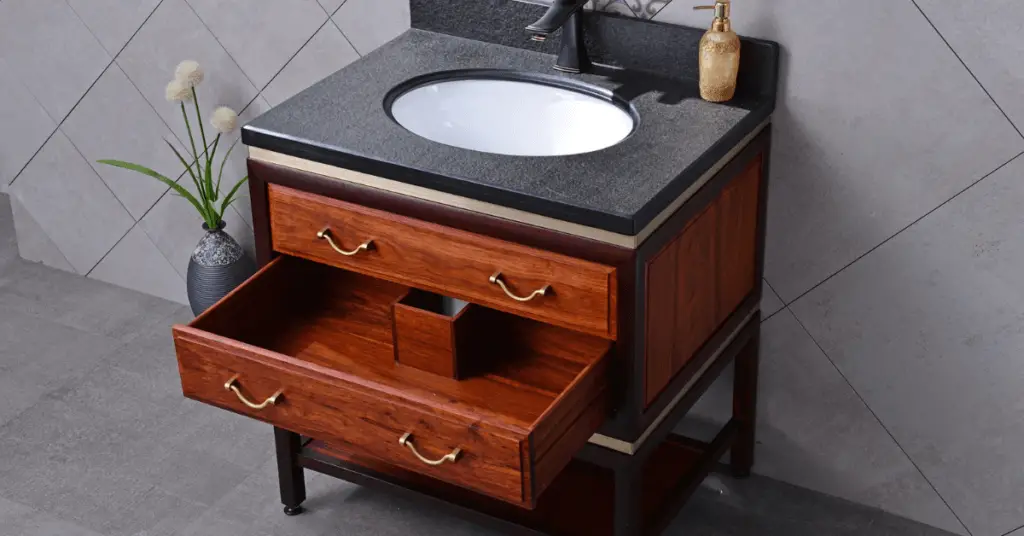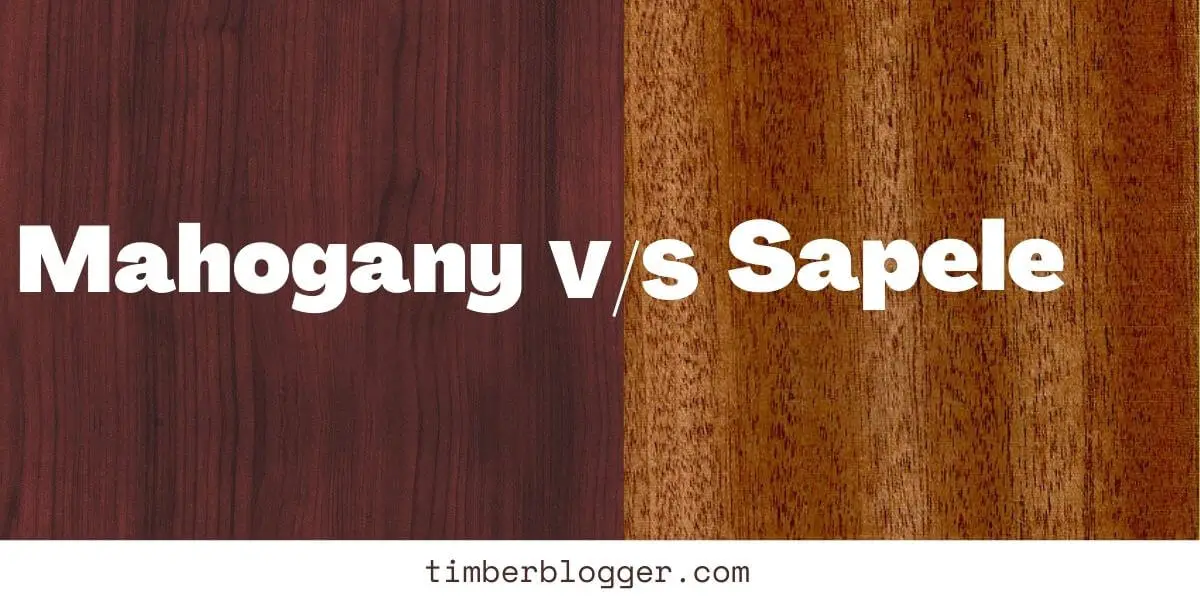Sapele wood is harder and stronger than Mahogany, but mahogany wood is darker and more popular than Sapele. Sapele and Mahogany are very similar to each other in many respects. Hence, Sapele wood is the first alternative to Mahogany.
Mahogany Wood
Mahogany is a durable, stable, and rot-resistant hardwood. It is famous for many reasons, such as its rich appearance, durability, and stability. It is native to South America and Mexico.
There are many species of mahogany, but there are only three genuine mahogany, which are as follows: Honduran mahogany (Swietenia macrophylla), Cuban mahogany (Swietenia mahagoni), Pacific Coast mahogany (Swietenia humilis).
Sapele Wood
Sapele is a dense and strong wood, making it a popular choice for furniture and other woodworking projects. It is native to Africa.
Sapele is a member of the Mahogany family. It is an excellent alternative to genuine Mahogany. Sapele is stiffer and heavier than Mahogany. It is 16% harder than Red Oak and less prone to scratches and dents. It is perfect for flooring.
Difference Between Mahogany and Sapele
| # | Mahogany wood | Sapele Wood |
| Scientific name: | Swietenia | Entandrophragma Kilindricum |
| Uses | Furniture, cabinet, flooring, and boatbuilding. | Veneer, Plywood, Furniture, Cabinetry, Flooring, Boat Construction, and Musical Instruments. |
| Color: | Reddish-brown | Golden to dark reddish-brown. |
| Hardness: | 900 lbf (4,020 N) (Honduran mahogany) | 1,410 lbf (6,280 N) |
| Average Dried Weight: | 36.8 lbs/ft3 (590 kg/m3) (Honduran mahogany) | 42 lbs/ft3 (670 kg/m3) |
| Bending Properties: | It can bend and carve easily. | It can bend easily. |
| Workability | Easy to work | Easy to work |
Uses of Mahogany Wood and Sapele Wood

Mahogany wood is widely used for furniture, cabinets, carpentry, veneer, plywood and musical instruments. It has good resistance to water and rot. So, Mahogany wood is perfect for kitchen cabinets, bathroom doors and boat building.
Sapele wood is used for furniture, cabinetry, and other construction materials. It is suitable for interior and exterior uses. Sapele wood is also famous for making guitar bodies and necks because of its hardness and bending properties.
Musical Instruments
Mahogany is one of the most popular woods for making guitar bodies. It is a beautiful tonewood for musical instruments and holds excellent acoustic properties.
Mahogany is more famous than Sapele for making musical instruments. Sapele is used as the best alternative to Mahogany.
The interlocking grain of Sapele gives the guitar a strong body, and the rich dark color gives a great appearance. It is much harder than African Mahogany but still easy to bend for guitar bodies.
Boat Building
Genuine Mahogany is naturally rot-resistant and moisture-resistant, which makes it a suitable wood for boat building. Mahogany stands up extremely well to water and moisture.
Sapele wood is less rot-resistant than Mahogany, but it is used for boats because it is extremely hard and dense enough that moisture does not penetrate the wood.
Scratch Resistant Flooring
Mahogany and Sapele are excellent choices for flooring, as they have sufficient hardness to reduce the chances of dents and scratches significantly.
Mahogany flooring is a very durable and attractive option. It requires less care and maintenance. Mahogany flooring is 70 to 80% more stable than many other hardwoods. So, it can be an excellent choice for durable flooring.
Sapele Wood and Mahogany for Outdoor use
Mahogany is an ideal wood for outdoor use because it is resistant to shrinking, splintering, and checking. It is the king of hardwoods. Mahogany is durable enough to withstand weather and moisture.
Sapele wood is used for outdoor applications such as garden furniture and beach chairs. Sapele wood is stronger than Mahogany. It is moderately rot-resistant and weather-resistant. It firmly lasts for several decades without changing its properties.
Appearance: Color and Grain
Mahogany is darker than Sapele wood. Mahogany color can vary from a pale pinkish brown to a darker reddish brown, while Sapele wood is golden to dark reddish brown.
Sapele and Mahogany wood color tend to darken with age. When wood is exposed to direct sunlight, the color change occurs even more rapidly.
Mahogany has straight, interlocked, irregular, or wavy grain, while Sapele has interlocked and wavy grain with fine texture.
Sapele or Mahogany: Which Wood is Easier to Work With?
Mahogany is slightly easier to work with than Sapele because Sapele is harder and denser than mahogany, but both Sapele and mahogany wood are easy to bend and finish.
Mahogany wood is relatively easy to work with. It is easy to cut, sand, and route. Wood is rigid and heavy but easy to work with. Irregular grains can cause the problem of tearing out. Mahogany takes the stain exceptionally well. Use shellac and lacquer for better-finishing results.
Sapele wood is harder than many domestic hardwoods. So, it can be troublesome to work in some machining operations, such as a slight blunting effect on cutters. Using hand tools for Sapele may be too harsh for you.
Tips When You’re Working with Mahogany and Sapele Wood
Working with mahogany and Sapele wood is a beautiful experience, but it can also be challenging due to the hardness and grain patterns. Here are some tips to help make the process easier:
- Use a sharp saw blade. A dull blade will cause tear-out problems.
- Mahogany and Sapele have been reported as skin and respiratory irritants, so wear a protective mask and gloves when working with them.
- Sand well before finishing.
Availability
Mahogany is readily available, but you may have to pay a higher price for genuine mahogany as it is rare. The United States is the largest importer of mahogany.
Sapele is readily available. It is not listed in the CITES Appendices but as “Vulnerable” in the IUCN Red List. The sample tree population has decreased by 20% in the last three generations.
Sapele vs Mahogany Sound
Mahogany and Sapele wood are known for their excellent sound and have long been used to make guitars and other musical instruments. Sapele wood has a brighter tone, while mahogany has a warmer tone. Mahogany has a weak treble presence, and Sapele has a strong treble presence.
It’s hard to say which wood sounds better as it depends on your particular taste in sound.
Sapele or Mahogany: Which is More Expensive?
Mahogany wood is rare and more expensive than Sapele wood. Mahogany wood ranges from $5 to $30 per board foot, while Sapele wood costs $5 – $10.
The price of wood depends on many factors, such as the wood’s quality and the board’s size. Long-sized Boards are more expensive than short-sized Boards.
Hardness
Sapele is harder and heavier than mahogany. The Janka hardness of Honduran mahogany is 900 lbf (4,020 N), while the Janka hardness of Sapele is 1,410 lbf (6,280 N).
You can compare the hardness of Sapele and mahogany to other popular woods in the table below to get an idea about how hard Mahogany and Sapele wood are.
| Wood Species | Janka Hardness |
| American Chestnut | 540 lbf (2,400 N) |
| Black Ash | 850 lbf (3,780 N) |
| Honduran mahogany | 900 lbf (4,020 N) |
| Black Walnut | 1,010 lbf (4,490 N) |
| Mango | 1,070 lbf (4,780 N) |
| Sapele | 1,410 lbf (6,280 N) |
| Hard Maple | 1,450 lbf (6,450 N) |
| Honey Locust | 1,580 lbf (7,030 N) |
Why is Mahogany so valuable?
Mahogany is a beautiful, durable wood prized for its rich, deep color and grain. Mahogany is a rare hardwood. It has low supply and high demand. A true or genuine Mahogany tree is only found in Central and South America, but demand exists worldwide.
It is a popular choice for furniture, flooring, and other wood products because of its strength and durability. Mahogany is also famous for its unique appearance, which can vary depending on the source and type of Mahogany.
Is Sapele the same as Mahogany?
Sapele and Mahogany are very similar to each other but not the same. The color of Sapele wood is slightly lighter than Mahogany wood, and it is harder. Sapele is very similar to Mahogany in quality, so Sapele wood is an excellent alternative. Both kinds of wood have their characteristics and use.
Read another related post


Comments are closed.